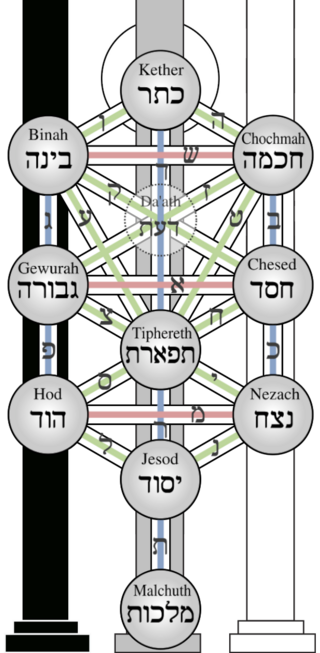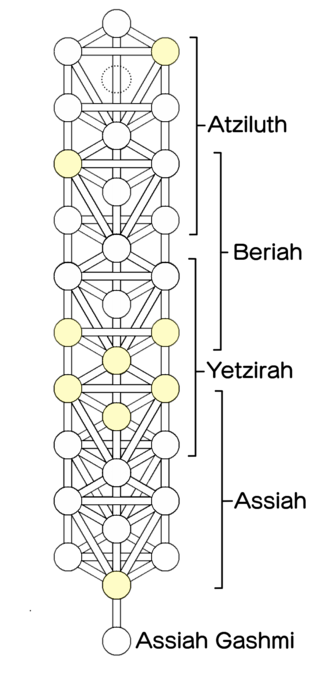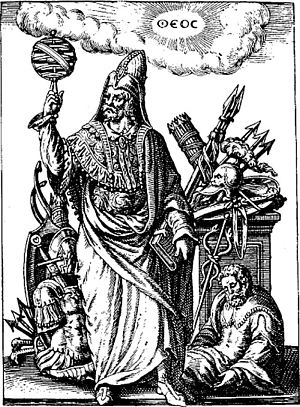
Hod is the eighth sephira of the Kabbalistic Tree of Life. It is positioned on the left side of the tree beneath Gevurah (severity) and directly opposite Netzach (eternity).
In the Zohar, Lurianic Kabbalah, and Hermetic Qabalah, the qlippoth, are the representation of evil or impure spiritual forces in Jewish mysticism, the opposites of the Sefirot. The realm of evil is called Sitra Achra in Kabbalistic texts.
Bahir or Sefer HaBahir is an anonymous mystical work, attributed to a 1st-century rabbinic sage Nehunya ben HaKanah because it begins with the words, "R. Nehunya ben HaKanah said". It is also known as Midrash of Rabbi Nehunya ben HaKanahמִדְרָשׁ רַבִּי נְחוּנְיָא בֶּן הַקָּנָה.

Sefirot, meaning emanations, are the 10 attributes/emanations in Kabbalah, through which Ein Sof reveals itself and continuously creates both the physical realm and the seder hishtalshelut. The term is alternatively transliterated into English as sephirot/sephiroth, singular sefira/sephirah.

In the branch of Jewish mysticism known as Kabbalah, Daʻat or Da'ath is the location where all ten sefirot in the Tree of Life are united as one.
Ein Sof, or Eyn Sof, in Kabbalah, is understood as God prior to any self-manifestation in the production of any spiritual realm, probably derived from Solomon ibn Gabirol's term, "the Endless One". Ein Sof may be translated as "unending", "(there is) no end", or infinity. It was first used by Azriel, who, sharing the Neoplatonic belief that God can have no desire, thought, word, or action, emphasized by it the negation of any attribute. Of the Ein Sof, nothing ("Ein") can be grasped ("Sof"-limitation). It is the origin of the Ohr Ein Sof, the "Infinite Light" of paradoxical divine self-knowledge, nullified within the Ein Sof prior to creation. In Lurianic Kabbalah, the first act of creation, the Tzimtzum self "withdrawal" of God to create an "empty space", takes place from there. In Hasidic Judaism, the Tzimtzum is only the illusionary concealment of the Ohr Ein Sof, giving rise to monistic panentheism. Consequently, Hasidism focuses on the Atzmus divine essence, rooted higher within the Godhead than the Ein Sof, which is limited to infinitude, and reflected in the essence (etzem) of the Torah and the soul.

Chokmah is the Biblical Hebrew word rendered as "wisdom" in English Bible versions. It is the second of the ten sefirot in Kabbalah, and represents the first power of conscious intellect and subtle manifestation, emerging from Keter's pure potentiality. It embodies wisdom coming from nothingness, as highlighted in the Book of Job and the Bahir. Chokmah is the primordial point of divine wisdom that becomes comprehensible through Binah.

Binah is the third sephira on the kabbalistic Tree of Life. It sits on the level below Keter, across from Chokmah and directly above Gevurah. It is usually given four paths: from Keter, Chokmah, to Gevurah and Tiphereth.

Tiferet alternatively Tifaret, Tiphareth, Tifereth or Tiphereth, is the sixth sefira in the kabbalistic Tree of Life. It has the common association of "Spirituality", "Balance", "Integration", "Beauty", "Miracles", and "Compassion".
Atziluth or Atzilut is the highest of four worlds in which exists the Kabbalistic Tree of Life. It is also known as "near to God." Beri'ah follows it. It is known as the World of Emanations, or the World of Causes. In the Kabbalah, each of the Sephiroth in this world is associated with a name of God, and it is associated with the suit of wands in the tarot.

Malkuth, Malkhut, Malkhuth, or Malchus, is the tenth of the sefirot in the Kabbalistic Tree of Life.

The tree of life is a diagram used in Rabbinical Judaism in kabbalah and other mystical traditions derived from it. It is usually referred to as the "kabbalistic tree of life" to distinguish it from the tree of life that appears alongside the tree of the knowledge of good and evil in the Genesis creation narrative and well as the archetypal tree of life found in many cultures.
Godhead refers to the aspect or substratum of God that lies behind God's actions or properties, and its nature has been the subject of long debate in every major religion.

The Four Worlds, sometimes counted with a primordial world, Adam Kadmon, and called the Five Worlds, are the comprehensive categories of spiritual realms in Kabbalah in a descending chain of existence.

Hermetic Qabalah is a Western esoteric tradition involving mysticism and the occult. It is the underlying philosophy and framework for magical societies such as the Hermetic Order of the Golden Dawn, has inspired esoteric Masonic organizations such as the Societas Rosicruciana in Anglia, is a key element within the Thelemic orders, and is important to mystical-religious societies such as the Builders of the Adytum and the Fellowship of the Rosy Cross.

Chesed is one of the ten sefirot on the kabbalistic Tree of Life. It is given the association of kindness and love, and is the first of the emotive attributes of the sephirot.
Partzufim or Partsufim, meaning "Divine Personas", are particular reconfigured arrangements of the ten sefirot, divine attributes/emanations of Kabbalah. Each partzuf is thus a configuration of disparate entities into a harmonious unit. The names of the partzufim are derived from the Zohar, the foundational text of Kabbalah. There, they are synonymous terms for the sefirot. Their full doctrinal significance emerged in 16th century Lurianic Kabbalah with reference to the cosmic processes of Tohu and Tikun, "Chaos and Rectification".
Arich Anpin or Arikh Anpin (Aramaic: אריך אנפין meaning "Long Face/Extended Countenance" (also implying "The Infinitely Patient One", is an aspect of Divine emanation in Kabbalah, identified with the sephirah attribute of Keter, the Divine Will.
The World of Chaos and The World of Rectification are two general stages in Jewish Kabbalah in the order of descending spiritual worlds known as "the Four Worlds". In subsequent creations, they also represent two archetypal spiritual states of being and consciousness. Their concepts derive from the new scheme of Lurianic Kabbalah by Isaac Luria (1534–1572), the father of modern Kabbalah, based on his interpretation of classic references in the Zohar.
Yichudim is a specific form of Jewish meditation in Kabbalistic Jewish mysticism, especially denoting the complete meditative method developed by Isaac Luria (1534–1572). The term Yichud is found in Halakha, denoting male-female "seclusion". In the esoteric anthropomorphism in Kabbalah, Yichudim denote unifications between male and female Divine aspects in the supernal sephirot.





